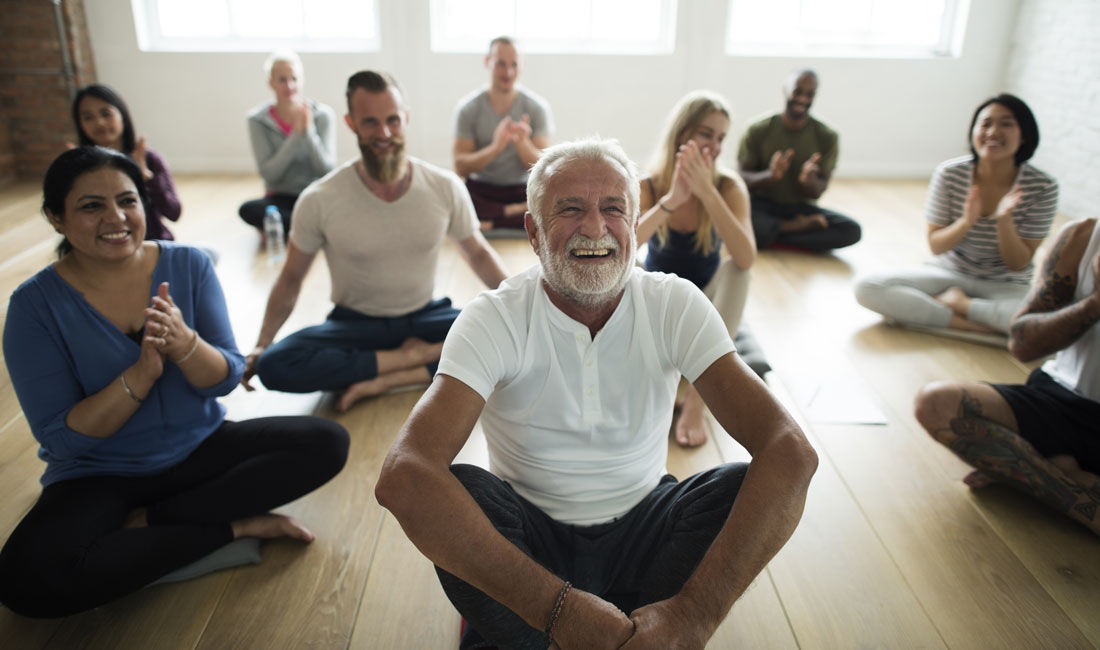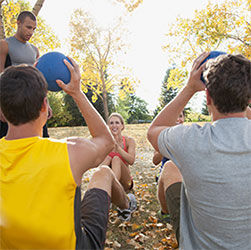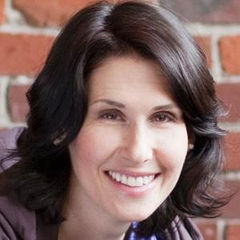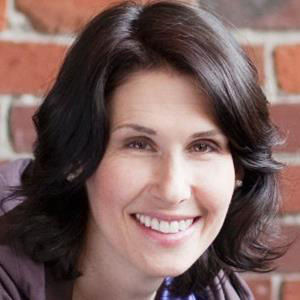
One thing we know for sure in the fitness industry is that building community among class participants and clients strengthens their commitment and motivation to exercise. It's a simple enough concept, but it can be difficult to put in motion without a definite plan. When you find the right formula for integrating a sense of belonging into your offerings, you’re more likely to retain clients long-term, ultimately helping them reach their health goals. Here’s what it takes to cultivate a community that’s essentially packaged within the fitness services you offer.
Why Community is Important
A lot of fitness studios, personal trainers and group classes offer pretty similar services and promised results, which makes it harder than ever to stand out. The fitness space is saturated with competitors, and there’s not much to stop others from doing what you’re doing, superficially anyway.
Your community is your differentiator—think of it as a sustainable safeguard within a fickle marketplace.
“Having a community is something your competitors can't take away from you,” says Tricia Murphy Madden, a fitness instructor in Seattle, Wash., and education director at Savvier Fitness. That belongingness drives business, keeping people engaged and coming back. Without the deeper meaning that community provides, it’s much easier to lose clients to a cheaper, newer or more trend-based competitor.
A 2018 study in Journal of Health Psychology shows that participants in group exercise classes reported higher levels of bonding and community belongingness compared to traditional gym members (Whiteman-Sandland, Hawkins and Clayton, 2018). Although these variables were not a predictor of actual gym attendance in this particular study, casual observation supports that connectedness among group fitness class participants fosters a community-driven approach.
“Community builds consistency and adherence,” says Ashley Varol, PhD, wellness manager at the University of Cincinnati and an ACE Master Trainer in Cincinnati, Ohio.
“More importantly, it creates a support system.”
Community leads to the kind of intrinsic motivation that health and exercise pros want for their clients, inspiring them to come to class, boot camp or the gym because they feel part of something.
“When people connect to other people or a place, it’s invaluable for their mental health, and extends to the greater community at large,” says Leanne Zdebiak-Eni, owner of Studio IPF: Inner Pursuit Fitness in Courtenay, British Columbia. She’s been so successful at building community within her small-town studio that clients tell her they go to her gym because they want to, not because they think they should. That’s a dream testimonial for any health and exercise professional to hear.
Bonding at the gym can be equally important for trainers and instructors, who act as “hosts” to their respective gym communities.
“Even as an instructor, it’s the community that keeps me teaching my class each week,” says Varol. “I love the connection, the progress and the feeling that I’m making a difference.”
How to Build Community
“Community begins with personal connections, sharing and giving,” says Madden. However, assembling people in a class, gym or boot camp doesn’t necessarily mean they’ll bond. In some gyms, members go about their business quite separately. Elsewhere, people socialize in person and on social media, know each other’s names and share stories about their progresses and setbacks. What makes the difference?
According to Madden, the trainer/instructor plays a crucial role here. “Once there’s an authentic connection between instructor/trainer and client, there becomes connection between client and client,” she says. “It’s truly when the clients connect with each other that the community becomes something great.”
An overall culture of acceptance also helps. “No matter people’s fitness level, size or age, we treat everyone equally,” says Zdebiak-Eni. “For many people, simply walking through our door is a huge deal and can cause major anxiety. They have no idea what to expect, and quite often are expecting the worst! If we can make them feel like part of our community, it can ease that stress.”
In addition to laying the groundwork for a tight community through acting as your community’s host, promoting acceptance and introducing clients to each other, trainers and instructors can structure activity programming around community-building. And don’t forget to learn names. “It seems simple, but it means so much to people,” says Zdebiak-Eni.
Here are a few additional ideas:
Partner up: In classes or group training, integrate partner work with exercise challenges and icebreakers. Varol recommends not letting participants pick their own partners though. Pair up people who might not normally interact, or match class regulars with newbies. You could also create visual cues around partner work.
“I try to make certain equipment partner-based, like SandBells, BOSUs or medicine balls,” says Varol. “When participants see this equipment, they know there’s something fun coming.”
Encourage conversation: Madden makes a point of acknowledging birthdays and special occasions in class. She also asks questions, such as, “Who has good news today?” “More often than not, hands go up,” she says. “Members have to find a reason to connect or else they are just there sweating and doing burpees.”
Play games: Varol likes to set up the workout room with designated areas for certain commonalities/traits/preferences, such as birthdays, pets, kids, favorite food, etc. Then she asks participants to group together according to what descriptor fits them best—this is a fun, easy way to inspire bonding. Another idea is to arrange relays or boot-camp stations and offer prizes or recognition for the loudest or most supportive teams. “Give participants a chance to shine,” says Varol.
Venture outside the gym: At the gym, plan and train for an event that takes people away from the facility, such as a hike, 5K, retreat or active getaway. (This could also become a good revenue stream for you!)
“It’s great to get members together outside of the studio,” says Zdebiak-Eni. “We see people who might not ordinarily have time to chat in class talking to others.”
Hire your community members: It’s not uncommon for regular members and participants to become interested in working in the fitness industry. As a community host, you can leverage that excitement to strengthen connections.
“One of the best things I've done for community at our studio is hire clients,” says Zdebiak-Eni. “I mentor them through their training and provide lots of support. They already know exactly what we’re all about and they project that to their classes when they start teaching.”
Community Involves Time Commitment
Connections With Your Fitness Peers
You likely consider yourself part of your client/member/participant community. But for professional inspiration and belongingness, it’s also smart to align with a community of health and exercise professionals. Here are a few ideas for finding motivating professional connections:
- Organize, host and/or attend regular staff meetings or socials.
- Attend conferences and plan ahead for networking opportunities.
- Join one or more professional associations.
- Stay up to date with your fitness certifications.
- Engage with other trainers and instructors via social media, such as on ACE’s Instagram and Facebook channels.
- Arrange or attend meet-ups for health and exercise professionals in your city.
- Meet local fitness friends for business brainstorming or just to socialize.
“In the beginning, it’s great fun to have a fan base of members who truly love you and your classes,” says Madden. “They create a buzz and energy, they give the best positive feedback and they invite friends to your workouts—it’s pretty incredible.” However, connections like these often require more thought and effort than simply coming in, teaching your class and leaving. There’s a time commitment.
“Once an instructor or trainer has a fitness tribe of their own, there’s work to be done,” says Madden. Participants might want to socialize with you outside the gym or request more excursions than you have time to plan or participate in. This could become a downside, depending on your other job and life responsibilities.
However, for a studio owner like Zdebiak-Eni, it makes sense. “It definitely takes up a portion of my time on a regular basis,” says Zdebiak-Eni. “But I consider it an important part of my studio’s vision and it helps maintain clients, so it’s worth it to me.”
If you simply teach a class and don’t own a studio or training business, it might become a different story. “A community or following can begin to demand or request time with their instructor/trainer outside of the fitness facility that may start to weigh the instructor down,” says Madden. To avoid this, Varol keeps her time commitment to just the class. “Everything I do is during my class time, so there is minimal time required,” she says. “Just a little bit of thoughtfulness in planning ways to bring the group together.”
“If it begins to feel like a job to socialize in addition to the time you spend coaching, I would suggest putting parameters around gatherings,” says Madden. For example, perhaps you agree to meet socially every month or two so participants know not to expect a coffee get-together after every class. (Of course, if they go together without you, great!) Ultimately, you must decide what’s appropriate based on your own circumstances and goals.
Facilitators of Friendship
Trainers and instructors are so much more than fitness teachers. We connect people. We bolster belonging. “We are the facilitators of friendship,” says Varol. The gym is the perfect place to help people make meaningful connections supported by health and fitness. “We can help people find friends through our classes,” continues Varol. “It takes some intentionality, but when it happens, it’s cool to see!”
Reference
Whiteman-Sandland J., Hawkins, J. and Clayton, D. (2018). The role of social capital and community belongingness for exercise adherence: An exploratory study of the CrossFit gym model. Journal of Health Psychology, 23, 12, 1545-1556.
Expand Your Knowledge
Small Group Training: Program Design for Healthier Communities [live webinar]
 In this video training, ACE Certified Personal Trainer and founder and owner of San Diego Premier Training Mike Deibler MS, CSCS will show you how to put systems in place to screen clients for small group training. He will also explain how to create a periodized plan for a group of participants having different fitness levels and needs. With information about proper client intake, modifications, different motivation/leadership styles and proper planning for a variety of individual needs, this course will set you up for small group training success.
In this video training, ACE Certified Personal Trainer and founder and owner of San Diego Premier Training Mike Deibler MS, CSCS will show you how to put systems in place to screen clients for small group training. He will also explain how to create a periodized plan for a group of participants having different fitness levels and needs. With information about proper client intake, modifications, different motivation/leadership styles and proper planning for a variety of individual needs, this course will set you up for small group training success.
You will learn:
- How to screen clients to determine if they are a good fit for a small group training program
- The proper progression and regression models for individualized program design within a group setting
- Different periodization models to use for small group training
- How to use group training to build a community of followers and advocates for your program
Course Schedule
MAY22
REGISTER NOW





 by
by 

 In this video training, ACE Certified Personal Trainer and founder and owner of San Diego Premier Training Mike Deibler MS, CSCS will show you how to put systems in place to screen clients for small group training. He will also explain how to create a periodized plan for a group of participants having different fitness levels and needs. With information about proper client intake, modifications, different motivation/leadership styles and proper planning for a variety of individual needs, this course will set you up for small group training success.
In this video training, ACE Certified Personal Trainer and founder and owner of San Diego Premier Training Mike Deibler MS, CSCS will show you how to put systems in place to screen clients for small group training. He will also explain how to create a periodized plan for a group of participants having different fitness levels and needs. With information about proper client intake, modifications, different motivation/leadership styles and proper planning for a variety of individual needs, this course will set you up for small group training success.
